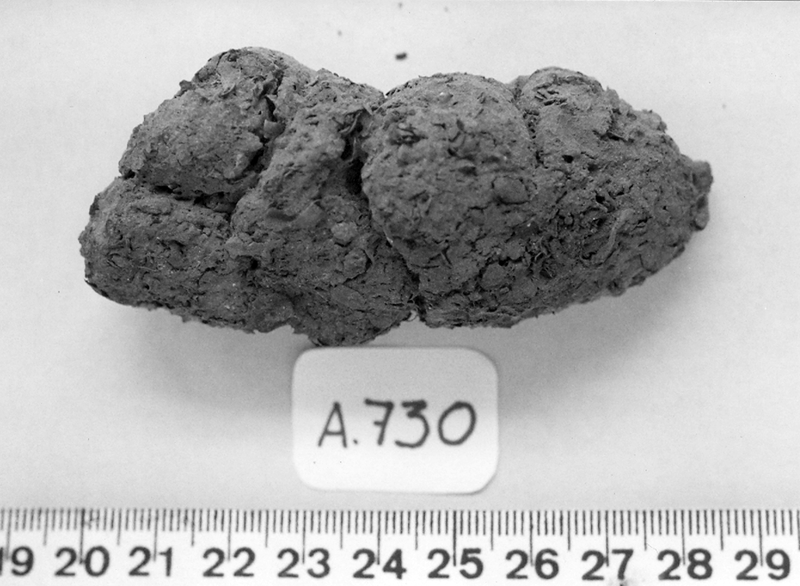To Truly Know an Ancient Society, One Must Analyze Its Feces

A human coprolite (Photo: Sianto et al. 2012/Wikimedia)
Archeological digs, like any work environment, can get tedious. Even scientists need to have fun. In the 1960s, at one of Vaughn Bryant’s first digs, workers would collect “dozens of flat, cow patty-shaped human coprolites”–hunks of ancient human fecal matter–through the course of the morning. After lunch, those coprolites would be used as entertainment.
The game was to see how far the patties could be thrown, frisbee-like, from the site. “As each coprolite sailed out over the canyon the crowd would cheer or launch, depending on how far the thermal updrafts carried each coprolite,” Bryant writes, “It was great sport.”
But Bryant, a Texas A&M professor who studies fossil pollen and ancient human feces, would later come to consider the information contained in those dried patties “some of the most valuable data being excavated,” which could reveal otherwise unknowable detail about ancient diets and parasitic infections. In the 1960s, serious study of ancient human poop had only just begun, and almost almost no one saw its value. Now, though, there are dozens of researchers around the world who have developed a special focus on fecal matter.

Paleoparasitologists might find whipworm eggs in ancient fecal samples (Photo: CDC)
There were some scattered examples of scientists examining ancient human fecal matter in the early 20th century: archaeologists analysed the guts of mummies for parasite infections, for instance. But serious study of coprolites did not begin until the mid-20th century, when researchers at McGill tried to examine Peruvian fecal samples for evidence of parasites.
One of those researchers, Eric Callen, shifted his research to focus on coprolites and published one of the first major papers in this line of research in 1967. He also developed a technique for rehydrating coprolite samples, in a particular chemical solution, which would allow scientists to more closely study the parasite eggs contained within and led to a bump in basic paleoparasitology studies.
Still, up until the ‘80s and ‘90s, the field was still extremely small and often dismissed. Some key archaeologists in charge of excavations did not keep coprolites, and when Callen died unexpectedly, his university destroyed his collection of several hundred. At the same time, though, advances in microscope technology were increasing the depth and breadth of the data that could be extracted from fecal samples. In one 1970s study, for instance, a coprolite analyst was able to tell how the grains in different coprolites had been ground, cooked, and chewed.
Techniques for collecting and analyzing fecal samples were also improving, and the field made another leap forward when DNA analysis became more common. It gave researchers a new tool for identifying parasites, but also gave coprolites a new value, as fecal samples can be an excellent source for ancient human DNA.

Coprolite analysis now involves examining samples for pollen grains (Photo: Janice Carr, USCDCP)
Once, coprolites from archaeological sites would all be placed in one bag (or maybe several), which is how they would be stored and transported. But that can create cross-contamination, says Karl Reinhard, an environmental archaeologist and coprolite expert at University of Nebraska-Lincoln.
“These days, when you find a coprolite, the archaeologist gets in one of those sterile hazmat suits and double gloves, samples it, and puts it in a sterile container,” he says. Genetic testing can determine if it came from a human. In Reinhard’s sterile lab, the air is filtered so that there’s no contamination of the samples. “Anything smaller than a pollen grain doesn’t get into the lab,” he says, “We take sterile scalpels and section the coprolites, and put them back into sterile containers.”
The best practice, Reinhard says, is to save half of any sample for future analysis. The other half is analyzed for fibers, bones, plant epidermis, pollen, parasite eggs and other bits of microscope evidence. In Reinhard’s lab, they quantify everything, which allows them to measure, for instance, the intensity of parasitological infection.
Coprolites are not the only form in which scientists collect human fecal matter. They can also obtain such samples from ancient latrines and other long-abandoned dumps or directly from human corpses, often preserved by mummification, dry heat, or freezing temperatures. Some specialists are building substantial collections of fecal samples, from all over the world. Piers Mitchell, a paleoparasitologist at the University of Cambridge, who is working on creating “a comprehensive collection of ancient faecal samples,” has hundreds of samples, primarily from Europe, the Middle East, Africa and Asia.
These sorts of collections can be used to reveal details about the past that otherwise would be lost forever. In one study, Mitchell found that King Richard III was infected with roundworm; in another, he identified an early example of how irrigation channels might have spread disease. Reinhard’s work has looked at the effects of natural climate fluctuation on tapeworm infections on the coast of Chile, and how the expansion of the Incan Empire affected parasitism in agricultural villages.
Collecting fecal samples could also tell us about other branches of our evolutionary tree. “No one knows for sure what types of parasites might have infected Neanderthals or Homo erectus, for example,” Mitchell says. “Identifying the parasites that infected other hominins would show their lifestyle might have made them prone to infection by different species of parasite, and also how their infections compared with early humans living a similar lifestyle.” He’s keen to add a variety of hominin samples to his collection.




































Follow us on Twitter to get the latest on the world's hidden wonders.
Like us on Facebook to get the latest on the world's hidden wonders.
Follow us on Twitter Like us on Facebook